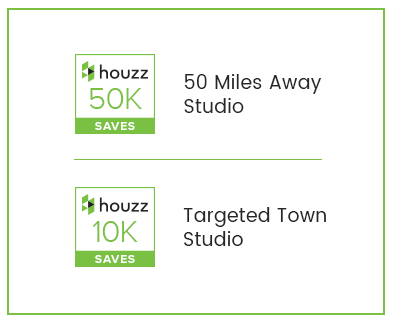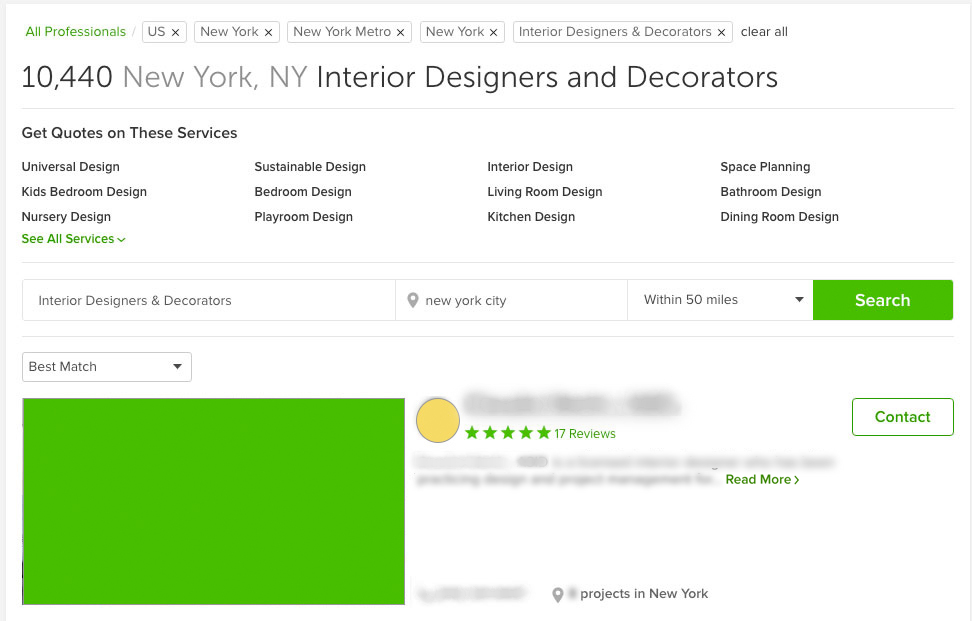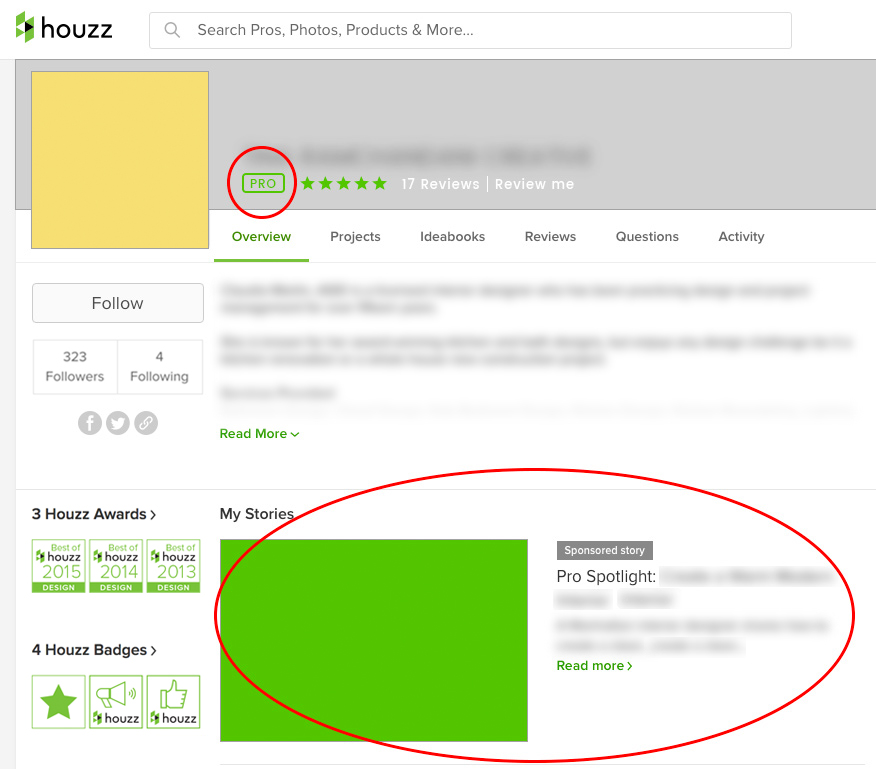Houzz Changes: Local Pros Hurt

Houzz updated their pro directory search algorithm and by our carefully researched estimates, there are more losers than winners. Read on to discover what they did when they thought no one was watching.
2/19/2018 Update: After bringing these issues to light this last week, Houzz has again updated their algorithm and these issues no longer apply.
OBSERVATION #1
Rather than the local Houzz pro directory having designers that primarily live or work in the specific town, now they are pulling more from a 50-mile radius.
Example: Up to recently, if you searched for interior designers in South Haven, Michigan, you’d see at the top of the pro directory the logical choice, Bayberry Cottage. They have a bricks and mortar home design store and studio there and their 12-person team are fixtures in the community. They are the designers of the town.
Now, with the algorithm change, one instead finds at the top a design studio located a full 50 miles as the bird flies away- which is a 60 mile, one hour drive away.

In SEO terms, Houzz adjusted the ranking factors in their algorithm- the mathematical equation that decides what factors go into determining the order of their directory listings and the weight given to each of those factors. Now they are showing less relevant results, by our estimates.
This hurts the searcher because they most likely entered Houzz after searching in Google for “South Haven interior designers” and the top result was a link to Houzz. Google’s job is to recommend good sites. When they refer homeowners to Houzz, they wouldn’t expect that Houzz would then deliver quasi-local results for a hyperlocal search.
This hurts local home pros because this consolidates visibility to fewer pros within a 50-mile radius. Instead of more pros having their piece of the action staked out in terms of locality, now there is a movement towards fewer pros getting a bigger piece of the pie. Which, of course, leads to more pros needing to pay Houzz to be seen in their areas.
In a sense, this isn’t a Houzz-specific issue. This is not so different from the general movement from small local stores and providers to larger retail chains. This could support some designers to build bigger brands with more employees, and other designs could go out of business.
Our suggestion to Houzz: devalue pros outside of a 20-mile radius so that local talent gets the visibility it deserves.
OBSERVATION #2
Ideabook saves count more than they did in the past.

This image shows the gap in quantity of Ideabook saves that was likely a strong factor in the above displacement of the South Haven studio from first place. We saw this happening across all geographic areas.
This is related to the above issue- that a popularity metric given undue weight could create a gravitational pull to fewer home pros.
This creates a bit of a class system within Houzz as typically, but certainly not always, the most liked images are from larger budget projects. This puts emerging designers and smaller studios in the uncomfortable position of needing to buy attention on Houzz. It creates an upper-class that lets its brand capital build while the rest scurry to survive paycheck to paycheck.
This move to give more credit for Ideabook saves helps Houzz to determine quality in a way that goes beyond the actions of profile management. So, it could be considered a better ranking factor than something like reviews which is often about who is willing to be the most persistent with clients. And, it could be considered a better ranking factor than where you are based and where your projects are located- as more local doesn’t mean better.
Thus, the intention of increasing the value of this ranking factor has merit. However, it seems to have been done in a way that is out of balance, leading to examples like the one shown above.
We remember the days of an old algorithm that also privileged Ideabook saves and the #1 designer in New York City was then an unnoteworthy designer who just happened to create a killer closet that the Houzz DIY audience ate up and saved enthusiastically. This is just one example of many of how an imbalance in the weight of a ranking factor can deliver poor user-experience, as the pro directory is for the buyers of services, not DIYers.
Our suggestion to Houzz: decrease the weight of this ranking factor. And, by devaluing the 20-50 mile radius as suggested above, collectively this won’t be as much of a problem.
OBSERVATION #3
Some pro’s high organic directory positions are hard to account for beyond their participation in Houzz’ advertising program.
We sincerely hope that this correlation isn’t true. And, when we brought this to Houzz’ attention they adamantly denied it. However, when we analyzed results we saw anomalies that we could only explain by this theory. (If Houzz sends us a sufficient and verifiable explanation, this section will be removed).
Note: The findings are related to the directory results from the time this article was published. Houzz has since changed the algorithm and thus this example is no longer at the top.
After examining the top result for interior designers in NYC, we simply can’t make sense of why the top design studio became #1. The one and only distinguishing factor that we see to make that studio rise above its competitors is that it subscribed not just to Houzz Pro+ advertising, but also to their premium sponsored stories. (Again, please say it ain’t so).

Here is the profile:

If this is a case, this move would transgress all commonly accepted ethical lines between journalism and advertising, between organic search engine results and paid ads.
We found a disproportionate amount of top positions awarded to Pro+ advertisers- with #1 positions often going to those with sponsored stories or paid profile videos.
We’ve seen a huge shift this week in the organic listings with Pro+ advertisers rising and those who don’t pay falling. We believe there should be a clear line between paid and earned placements, and the Houzz eco-system is absolutely blurring them. Either directly or indirectly, advertisers are getting benefits in organic positions.
The founder of our design industry marketing agency, Ken Lewis, is an SEO expert. He shares:
Search engines, whether they be Google, Bing, or even the Houzz pro directory, are ultimately referral engines. It is the business of the search engine to produce the highest quality results for the searcher so that his or her needs are met quickly. We only trust and use search engines that provide such unbiased and carefully selected results. We want to see the most relevant results at the top. In this case, Houzz could be dangerously close to the line of breaking trust by offering ranking benefits that are largely accumulated by or through the benefits of paid advertising.
Designers have long accused Houzz on taking from the industry, and this algorithm can only reinforce that sentiment.
Previously Houzz has been under fire for:
- Demanding Houzz badges on designer’s websites for directory placement (as part of their profile being “complete”),
- Adding Houzz’ e-commerce tags onto the project images of designers- that all too often show low-quality products for Houzz’ DIYer base,
- Aggressively pitching designers with their one-size-fits-all Pro+ advertising solution that doesn’t actually fit all sizes so well and leaves many home pros feeling resentful.
We hope that by raising awareness on this topic that it will encourage conversation.
HOME PROS-
HAVE YOU YET NOTICED THIS ALGORITHM IN YOUR LOCAL RESULTS?
DOES IT AFFECT YOU FOR BETTER OR WORSE?
WHAT DO YOU THINK OF THIS?
Please share your thoughts with us in the comments below- and share this article with your friends to raise awareness of this situation.




